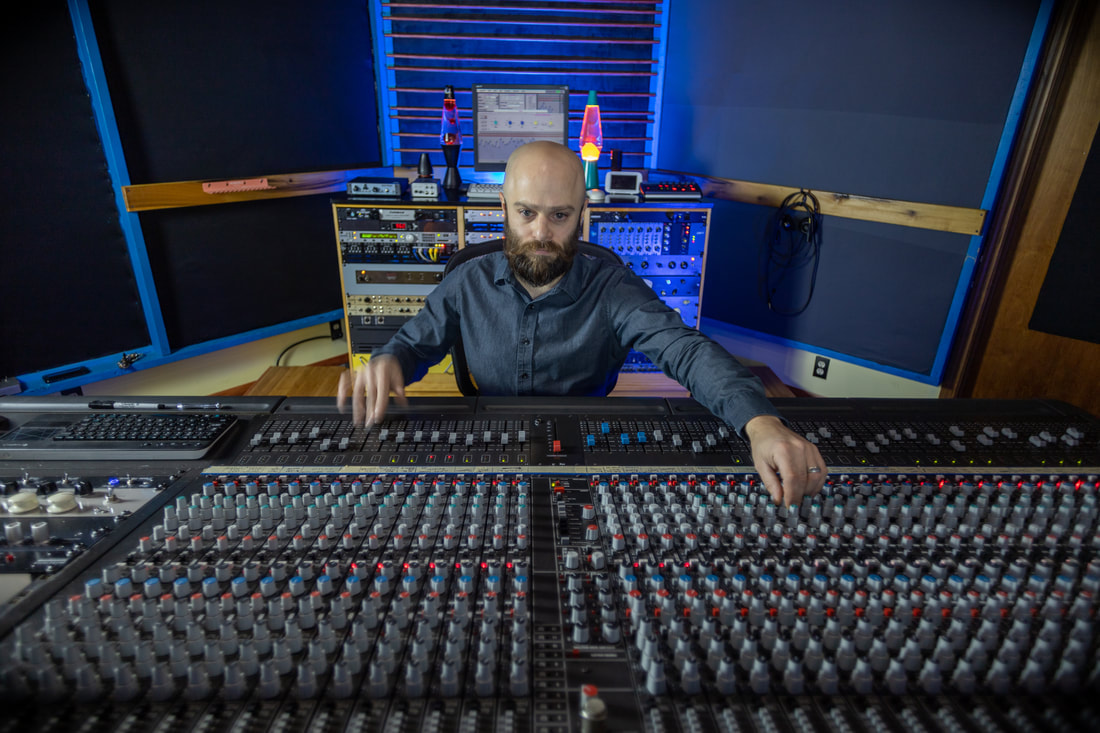|
Mixing usually takes me more than a day unless its a rough Mix for an ongoing project. We're done recording Don Z's 13 song acoustic album, so this week has been dedicated to Mixing. Today is the last day for Mixing the album, so much of the signal flow has been developed and I'll share some of it in this first blog post. To quickly sum up what its all about, I prefer to Mix in the analog realm entirely, but sometimes I'll use as little as one or as many as 8 plug ins in Pro Tools when Mixing. I prefer the sound of analog gear over its software imitations, so I'll try to get the sound I'm looking for with analog gear first. If I can't get exactly what I'm looking for with analog gear I'll then look to get there by adding on software plug ins.
First off, I was limited with the actual recording because the lead vocal and rhythm acoustic guitar were recorded at the same time, which were performed by Don. Can't get crazy with compression when there's lots of bleed between 3 microphones. The guitar was recorded in stereo with a close pair of small condensers to minimize phase & bleed issues. The lead vocal was a large vacuum tube condenser mic. Each song has different accompaniment, but the song I was last working on is the one I'll discuss. It's called Revisited and features a mandolin track and backing female vocals. The lead vocal should always be the prominent feature IMO. The goal here was to make it sound more impressive than anything else in the Mix. The lead vocal signal chain: DeEsser Plugin in Pro Tools => Altec 438c => LBA TEQ-1 passive EQ => Rectified Leveler. Too much compression on a vocal track with bleed is a bad idea, but here you'll see I was using two compressors on the lead vocal. Each one was set to compress very little. I was using them more for their gifts of warm tone and for their ability to make things sound bigger (something plugins can't do). The acoustic guitar track was getting a touch of compression from an Overstayer Stereo VCA compressor (similar to SSL G-Buss compressor, but with added functions), which was blended with the uncompressed signal to create parallel compression... a technique that preserves all the natural transients of the instrument while allowing compression to beef up the sound. As stated before there was limitations because of vocal bleed on the acoustic track. I had to simultaneously make changes to both the vocal and acoustic tracks to get them to work well together in terms of analog processing. I ended up tuning the Overstayer compressor to make the acoustic guitar notes ring a touch longer, which helped the guitar sound more full. Next was the backing female vocal track. This was tracked through the 1401 Stereo Microphone Amp and Rectified Leveler. It had a smooth tone, but with a bit of plate reverb on her voice, it sounded too smooth. Also, some of her words were difficult to make out. I ran her voice through the 1176 to counter act the smoothness and bring her words to the foreground. While the 1176 compressor helped considerably, it wasn't working well enough. Some words were still hard to make out, so I routed the signal from the 1176 to the X73i for some Neve-style EQ. Sucking out tons of low end from her voice, scooping out a touch of mids and pulling back on the treble just a hair was enough to make every word intelligible. It seemed like a lot of EQ, but it got her voice sitting perfect in the Mix and that's whats important. Moving on to the Mandolin, the sound seemed stringy in the Mix. It had lots of brightness and not enough mid-tone. I put a bunch of Plate Reverb on it, which made it fit better in the Mix, but some other work was necessary. I routed the Mandolin to a DBX 160X compressor (transformer output) which has a warm in-your-face solid state sound to it... and tends to remove some treble. The compressor brought out mid-frequency tone in the mandolin and controlled the variations in playing volume, but it wasn't enough to get it sitting perfect in the Mix. I routed it from the 160X to a modified PM1000 channel strip for some EQ. This EQ isn't very hi-fi, but it sounds warm and has a tone similar to the DBX 160x. I ended up cutting some low end, boosting the mids and cutting some highs to further accentuate what the compressor was doing. Panned the mandolin to the left, the female vocals to the right, lead vocal center, acoustic is stereo with a right side dominance. Adjusted levels and EQ'd the reverb (pre & post) to make the Mix sound open and voila its a complete Mix.
0 Comments
|
Details
AuthorMike Congilosi II, Producer and founder of Lightning Boy Audio shares occasional snippets of whats going on in the studio. Archives
March 2025
Categories |


 RSS Feed
RSS Feed